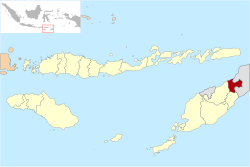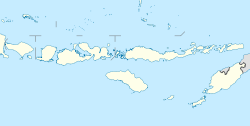Belu Regency
Belu Regency
Kabupaten Belu Rai Belu | |
|---|---|
Regency | |
 Coat of arms | |
| Nickname(s): Belu | |
 Location within East Nusa Tenggara | |
 Belu Regency | |
| Coordinates: 9°20′45″S 124°57′2″E / 9.34583°S 124.95056°ECoordinates: 9°20′45″S 124°57′2″E / 9.34583°S 124.95056°E | |
| Country | |
| Region | Lesser Sunda Islands |
| Province | |
| Settled | 20 December 1956 |
| Capital | Atambua |
| Government | |
| • Regent | Willy Lay |
| • Vice Regent | J. T. Ose Luan |
| Area | |
| • Total | 496.12 sq mi (1,284.94 km2) |
| Elevation | 1,230 ft (375 m) |
| Population (mid 2020)[1] | |
| • Total | 223,176 |
| • Density | 450/sq mi (170/km2) |
| Time zone | UTC+8 (ICST) |
| Postcodes | 856xx, 857xx |
| Area code | (+62) 389 |
| Religion | Christianity 95,45% — Catholic 88,39% — Protestant 7,10% Islam 4,30% Hindu 0,19% Buddha 0,02%[2] |
| Website | belukab |
Belu Regency is a regency in East Nusa Tenggara province of Indonesia. Established on 20 December 1958,[3] Belu Regency has its seat (capital) in the large town of Atambua.
In December 2012 a separate Regency - Malaka Regency - was created from the twelve districts that formerly comprised the southern half of Belu Regency. Belu means friend in Tetum. The residual part of Belu Regency had a population of 188,163 at the 2010 Census, which rose to 206,476 at the 2015 Census[4] and was officially estimated at 223,176 at mid 2020.[5]
Administrative Districts[]
The Belu Regency was until 2013 divided into twenty-four districts (kecamatan), tabulated below with their 2010 Census population. In December 2012, the twelve southern kecamatan were removed to form the new Malaka Regency, leaving the 12 northern kecamatan in Belu Regency. The residual Belu Regency is thus composed of twelve districts (kecamatan), whose areas (in km2) and 2010 Census populations are listed below,[6] together with the official estimates for 2020.[7] The table also includes the location of the district headquarters, the number of administrative villages (rural desa and urban kelurahan) in each district, and its postal code.
| Name | Area (in km2) |
Population Census 2010 |
Population Estimate mid 2020[8] |
Admini- strative centre |
Number of villages |
Post code |
|---|---|---|---|---|---|---|
| Kota Atambua (Central Atambua) |
24.90 | 26,396 | 27,745 | Tenukiik | 4 | 85711 -85718 |
| Atambua Barat (West Atambua) |
15.55 | 21,604 | 34,059 | Sesekoe | 4 | 85713 -85718 |
| Atambua Selatan (East Atambua) |
15.73 | 22,464 | 23,216 | Asuulun | 4 | 85716 -85718 |
| Total Atambua town | 56.18 | 70,464 | 85,020 | 12 | 85711 -85718 | |
| Raimanuk | 179.42 | 14,411 | 14,040 | Arekama | 9 | 85760 |
| Tasifeto Barat (West Tasifeto) |
224.19 | 22,362 | 22,814 | Kimbana | 8 | 85753 |
| Kakulak Mesak | 187.54 | 17,608 | 2,834 | Umarese | 6 | 85752 |
| Nanaet Dubesi | 60.25 | 4,006 | 29,058 | Tete Seban | 4 | 85751 |
| Tasifeto Timur (East Tasifeto) |
211.37 | 20,932 | 23,849 | Wedomu | 12 | 85771 |
| Western rural sector (a) | 862.77 | 79,319 | 92,595 | 39 | ||
| Raihat | 87.20 | 13,319 | 26,575 | Bei Sari Loo | 6 | 85773 |
| Lasiolat | 64.48 | 6,166 | 3,899 | Lafuli | 7 | 85771 |
| Lamaknen | 105.90 | 11,583 | 5,895 | Weluli | 9 | 85772 |
| Lamaknen Selatan (South Lamaknen) |
18.41 | 7,312 | 9,192 | Pie Bulak | 8 | 85770 |
| Eastern salient (b) | 365.99 | 38,380 | 45,561 | 30 | ||
| Totals for regency | 1,284.94 | 188,163 | 223,176 | 81 |
Note: (a) the five westerly rural kecamatan, mainly surrounding or south of Atambua. (b) the area projecting into East Timor.
Media[]
Belu Regency is served with four radio stations that cover the wider area around this regency (including Malaka Regency, Alor Regency, and Timor Tengah Utara Regency), which are RRI Pro1 Atambua (FM 91.5 MHz) RRI Pro2 Atambua (FM 99.8 MHz) RRI Pro3 (FM 99.0 MHz), and Saluran Citra Budaya Timor (alias Pro4) (FM 93.1 MHz). There's still a lot of radio that can be found in the town.
The regency is only served with two television stations (TVRI - including TVRI East Nusa Tenggara, Belu TV) and a few other East Timor stations that reach the border pass.
References[]
- ^ Badan Pusat Statistik, Jakarta, 2020.
- ^ "Kabupaten Belu Dalam Angka 2019". www.belukab.bps.go.id (in Indonesian). Retrieved 13 February 2020.
- ^ Government of Indonesia (9 August 1958), Establishment of the Second-level Administrative Regions under the First-level Administrative Region of Bali, West Nusa Tenggara and East Nusa Tenggara (in Indonesian ed.), Indonesia Ministry of Law and Justice, UU No. 69/1958, retrieved 24 August 2007[permanent dead link]
- ^ Badan Pusat Statistik, Jakarta, 2018.
- ^ Badan Pusat Statistik, Jakarta, 2018.
- ^ Biro Pusat Statistik, Jakarta, 2011.
- ^ Badan Pusat Statistik, Jakarta, 20209.
- ^ Badan Pusat Statistik, Jakarta, 2020.
- Regencies of East Nusa Tenggara
- East Nusa Tenggara geography stubs


